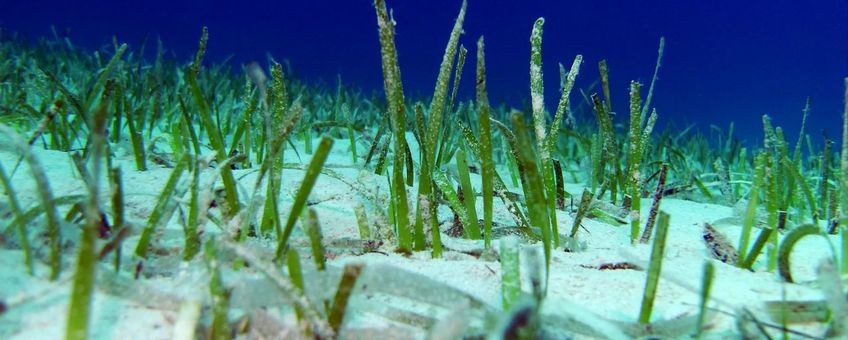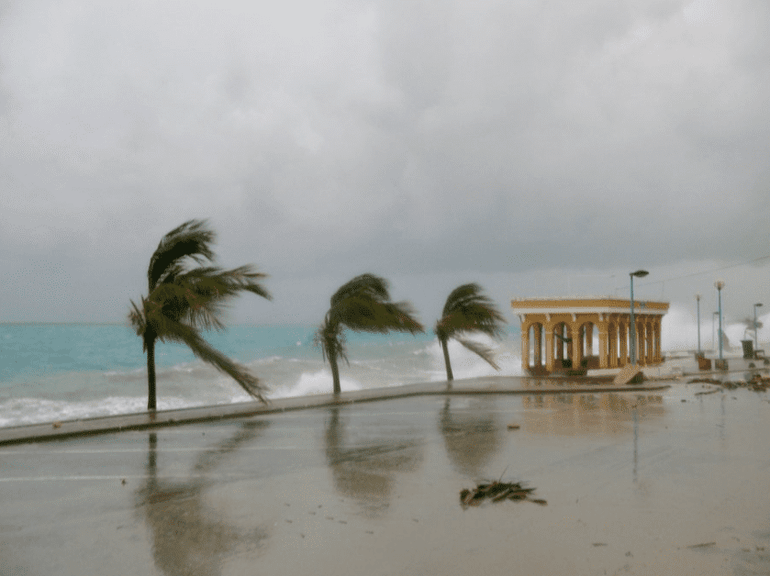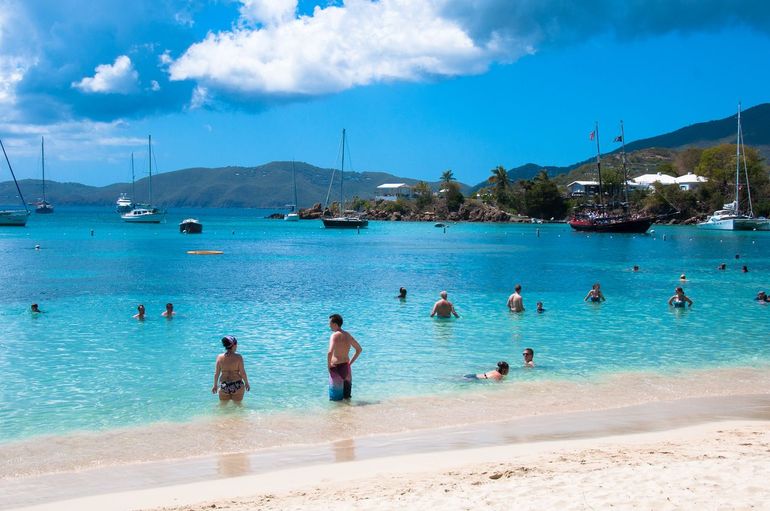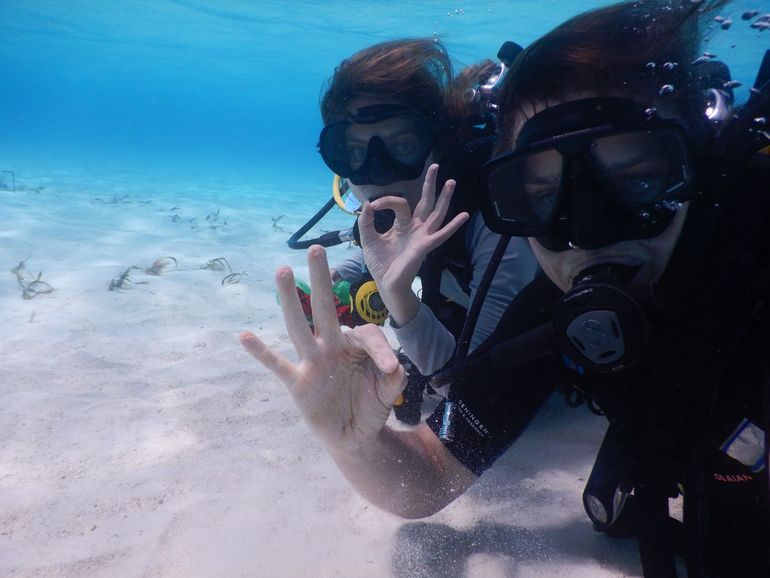
But seagrasses are facing a barrage of threats. We urgently need to protect them, and enable rewilding of the sea. Marjolijn Christianen, Associate Professor in Marine Ecology, and PhD candidate Fee Smulders explain why this is so important. Marjolijn researches how and where coastal ecosystems can be rewilded, and Fee studies tropical seagrass ecosystems. Together, they’ve spent years researching seagrass habitats in areas such as the Caribbean, and studying the threats to seagrass meadows.
“Seagrass is unusual because it was initially a terrestrial plant but then evolved back into the sea,” explains Fee Smulders. “A seagrass meadow is essentially like a regular grass meadow, but with shoots and leaves attached. There are about 60 different species, and their leaves range in length from a few centimetres to as much as six metres. Lots of fish species live amongst those leaves. For some, such as groupers and the stoplight parrotfish, seagrasses serve as a nursery. They grow up there and head off towards the coral once they reach adulthood. Other species, such as seahorses, live there permanently. There’s a huge level of biodiversity.”
On top of that, seagrass meadows are extremely important for carbon sequestration, which can help combat climate change. “Planting trees is always given as an example of how to capture carbon,” says Marjolijn Christianen. “But sea plants are even quicker and more efficient at doing this. Per square metre, seagrass meadows can capture up to twice as much carbon as temperate and tropical forests.”
A seagrass meadow along the coast of Bonaire (Source: WUR)
Algae choking seagrass
Seagrass is found all over the world, but it’s declining. It even used to grow in the Wadden Sea, but disease and the construction of the Afsluitdijk causeway killed it off. Seagrasses are facing a barrage of threats in all sorts of places, from the Mediterranean to the tropics.
These threats include sewage, soil and fertilisers finding their way into the sea, says Christianen. “Climate change is increasing the frequency of severe storms and heavy rainfall. This causes nutrient-rich water to drain into the sea, where it stimulates the growth of algae. In turn, this reduces the amount of light available to seagrass, which then kills it off.”
Meanwhile, coastal regions are also turning into construction sites. Building a harbour, for example, churns up the seabed and has the same effect. “And in the Maldives, hotels have often removed seagrass because tourists don’t like it swishing around their toes,” says Smulders. “By doing that, the hotels were actually causing problems for themselves because without seagrass there to anchor the sand, you lose your beach. Eventually, the hotel can even lose its own foundations. This has happened on Bonaire, where surf huts sometimes partially collapse into the sea.”

Unexpected threats
There’s also another, much less obvious big threat to seagrass. It comes courtesy of the sea turtle, which is actually thriving thanks to various conservation projects. It’s obviously great that local initiatives such as the protection of nests have led to sea turtle numbers going back up. “It also proves that people have the power to turn things around,” says Christianen.
But sea turtles eat mainly seagrass, and in places where seagrass is scarce the turtles are adding to the pressure. “We’re getting to the point where the system can no longer restore itself. It’s a negative spiral in which turtles are killing their own habitat. We have footage in which we can see up to 30 turtles per hectare hovering over the seagrass meadows. Their grazing habits damage the structure of the seagrass.”
This damage is now visible in the Bahamas and Bermuda. “In Bermuda there was a huge meadow that was over-grazed,” says Smulders. “As an experiment, we put a cage over a section of the seabed so that the turtles couldn’t reach it. We found that the seagrass was already so damaged that it barely grew back anymore. It will do eventually, but it’ll take decades. In the meantime any sea turtles there will have starved.”
Sea turtles as vloggers
Studying the impact of heavy grazing can reveal the risks to the entire ecosystem if there’s no timely intervention to protect the seagrass. A number of turtles have therefore had cameras attached to them as a way of documenting their grazing habits. The cameras were glued to the turtles’ shells and fell off after a few hours. They were then collected and the data was analysed. “This allows us to look at what exactly a turtle eats, the choices it makes, the times of day it eats, and how it interacts with other animals in the seagrass meadows,” says Christianen. “We think these behaviours can give us an insight into the health of the ecosystem as a whole, but this hasn’t been researched before. Camera systems have become very advanced. You can use them to find answers to a huge number of research questions. This research will soon be applied to manatees as well. A number of them will be equipped with a temporary camera. They’re already known as the vlogging manatees.”
Bringing back predators such as tiger sharks is another way of restoring balance to ecosystems that are under threat from overzealous turtles. Sharks influence turtle behaviour through what’s known as the fear effect. “Although sharks mainly focus on old and sick animals, they also have a significant fear effect,” says Smulders. “It’s important to explain this to turtle lovers: our objective is not for the sharks to eat lots of turtles, but for them to help restore a natural interaction. Rather than swimming leisurely around a seagrass meadow and gobbling it all up, they’ll just take a bite here and there because they’ll be keeping an eye out for the shark. They won’t be stripping it bare, which means the seagrass will be better able to recover.”
What do sea turtles eat, and when and where do they do so? This turtle is helping the researchers by ‘vlogging’ (Source: WUR)
Space for rewilding
Restoration therefore means looking at the entire system, and not just at a single species. It’s a delicate balance. To restore natural processes you need to give nature a break and let things develop. “You could see it as a passive form of rewilding,” says Christianen. “You’re not actually releasing sharks into the sea, you’re just creating favourable conditions so that the species comes back of its own accord. The idea is that this process of rewilding restores natural processes.”
Another seagrass project closer to home has shown how creating fallow areas is an effective way of giving nature some space. Staff at the University of Groningen and at NIOZ (the Royal Netherlands Institute for Sea Research) are working on reintroducing seagrass on Griend, the nature reserve island in the Wadden Sea. “They started by injecting seeds there,” says Christianen. “Within a few years, the project had grown from a plot of a few square metres into a 650 hectare area of seagrass. Biodiversity also increased by 32 percent over those four years. That’s actually pretty fast. So it shows what a fallow period can do. If you protect something in an area with favourable conditions, it can often restore itself.”
Recognise the value of seagrass
“It’s good to raise awareness of the importance of these ecosystems. It prompts governments to talk about it and to release funding,” says Christianen. “And with all the projects and threats out there, like an overabundance of nutrients in the sea, we need to consider the effects on seagrass. That’s why we need a clearer idea of where seagrass grows, what it needs for it to be able to restore itself, and where there’s the greatest potential for rewilding to take place.”
These things aren’t necessarily known, because until recently no one was paying that much attention to seagrass. It was only in the 1970s that the first studies of seagrass ecology were carried out. “It’s also much trickier to carry out research at sea than on land, and that’s why we’re lagging behind,” explains Smulders. “You need a boat, you have to dive and it’s more difficult using things under water.” Even so, the value of seagrass is gradually being recognised. The first World Seagrass Day is held on 1 March, with the support of the United Nations.
The agreements made at COP15, a conference on biodiversity held in Canada in December 2022, were also a step in the right direction. It was agreed that by 2030, 30 percent of land and 30 percent of the sea will be protected by leaving it entirely alone. That’s quite a big difference to the current situation in which around 17 percent of land and 8 percent of the oceans are protected. “It’s a promising step,” says Christianen. “However, we still need to look at which areas should be chosen in order to maximise the chances of success.”
People protect what they love
Even outside of the areas that will eventually fall under the 30/30 measure, small interventions can sometimes make a big difference. “People need to learn that it’s good to see seagrass when they’re swimming in the sea,” says Christianen. “And also that it’s better for boats not to drop anchor in seagrass meadows, just as they would no longer do over coral. Those anchors destroy the roots of seagrass, which then releases the stored carbon. These are simple things, and not very difficult to implement.”

People protect what they love, Jacques-Yves Cousteau once said. “That’s why we’ve brought tropical seagrasses to the Netherlands. And not just for scientific research in the greenhouses of Wageningen University & Research. We’ve also planted seagrasses at Burgers' Zoo in Arnhem. This will give everyone the opportunity to see these lush seagrasses in real life, alongside mangroves and manatees. That kind of exposure raises awareness, which is an important first step in conservation.”
“If we clearly articulate how we can protect seagrass, people will feel empowered to do something,” says Christianen. “It helps people overcome that sense of helplessness, and we know that taking local action really can combat the impacts of climate change on ecosystems. One example is connecting buildings to the sewer system to prevent discharge into the sea. This helps to keep seagrass healthy, so that it is better able to withstand climate change and continues to store carbon. It’s a sort of virtuous circle.”
And it’s not yet too late. The impact of humans on land is greater than our impact at sea. “The situation at sea isn’t yet as severe as it is on land. And there are more opportunities,” says Christianen. “We still have lots of scope for preventative measures, and there are a lot of gains to be made.”
Text: Wageningen University & Research
Photos: Greg Grimes, Flickr (lead image: seagrass in the Bahamas); Casper Douma, Saxifraga; Dave Herholz, Flickr; Marjolijn Christianen
Videos: Fee Smulders, Wageningen Environmental Research

